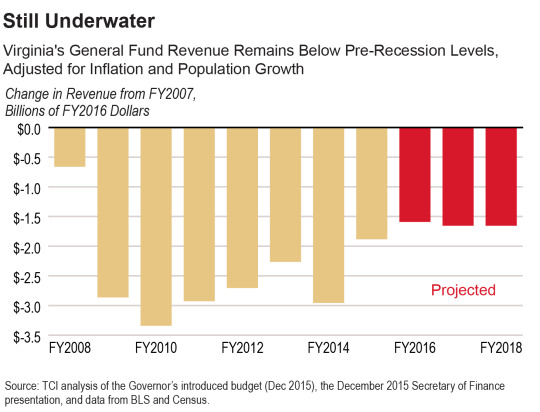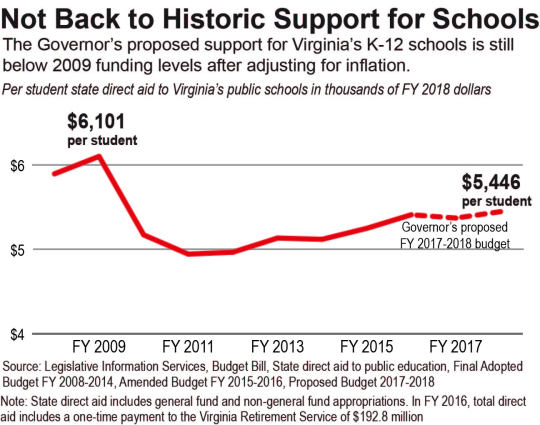December 18, 2015
The Governor’s Budget: First Thoughts
There’s a lot of good in Governor McAuliffe’s budget released yesterday. Large increases in state support for K-12 schools, and closing the health care coverage gap, for example. But there also some problems, most notably his tax break for big, profitable corporations.
Here’s our quick take on the big items we see in the proposal:
- Revenue is up, but still not where it used to be
- Increased investment in K-12 education filling part of a big hole
- Expanding health care coverage and directing savings to other areas
- A major step towards improving Virginia’s juvenile justice system
- Some progress unwinding gimmicks and meeting our pension obligations
Revenue is up, but still not where it used to be
Virginia’s economy has been doing pretty well lately, and as a result state revenue has ticked up, giving policymakers more money to invest in their priorities. But when we take a step back, we see that revenue is still low compared to the amount we should be investing in the building blocks of strong families, strong communities, and a strong economy.
The state projects general fund revenue growth of about 3.2 percent in 2016, 3.0 percent in 2017, and 3.7 percent in 2018. But that doesn’t account for the growing cost of providing the same level of services to a growing state population. After adjusting for those factors, the state’s ability to meet the needs of Virginia residents and economy is basically going to be holding steady for the next few years, if these projections are correct. Of course, that’s better than the years of real cuts during the recession, and come on the heels of very good real growth in 2015, but we’re still not back to where we were before the recession.

Virginia will still be missing about $1.7 billion a year in revenue during the next two years compared to 2007 revenue levels, after adjusting for projected inflation and population growth.
Increased investment in K-12 education filling part of a big hole
The governor’s budget shows real progress in rebuilding support for Virginia’s K-12 schools. He’s proposed an $850 million increase in general fund spending over the biennium, including funding for a salary increase for teachers, additional instructors, and for more support for services at high poverty schools. This last investment is essential, because cuts in state funding during the recession hit high-poverty schools the most, decreasing their support from the state by nearly three times as much as schools in better off communities.
The budget goes a long way to helping local school divisions that have had to cover the lost state support. Local governments in Virginia spent more than $3.6 billion beyond their required effort in FY 2014 to keep their schools running effectively. This added investment was necessary because the state funding formula was insufficient.
These investments bring state support to it’s highest nominal level in the commonwealth’s history in FY2018, at $5,446 per student. Yet, a dollar today does not have the same buying power as a dollar 10 years ago.
Adjusting for inflation, we see that these increases have not gotten us all the way out of the hole that we dug during the recession. Per pupil support will still be down by $731 per pupil in 2017 and $655 per pupil in 2018 compared to 2009 levels, after adjusting for inflation. That’s more than 10 percent below where we were.

Furthermore, most of these investments have not been built into the education funding formula, including the funding for additional instructors. This means, there is no guarantee they’ll be in future budgets and may fall prey to line item cuts from the general assembly.
Expanding health care coverage and directing savings to other areas
The governor included Medicaid expansion in his budget. Specifically, he proposes using the federal funds to lift eligibility and cover as many as 400,000 people using a hospital provider assessment to fund the state’s portion of the costs. His budget also books the $352 million in state budget savings in three areas – Community Service Boards, Department of Corrections, and the current Medicaid program.
And then he proposes directing $157 million of the savings to a wide array of programs.
The largest item – coming in at $64 million over the two year budget – is spent to pay for a corporate income tax rate reduction by a quarter of a percentage point. (See 6 Things to Know About Why the Governor’s Corporate Tax-Cut Proposal Won’t Work as Promised for our view.)
The next biggest item comes in at $42 million to increase in the personal/dependent exemption and aged/blind tax exemptions. These modifications will have a modest effect on reducing the amount of individual income tax people pay. The changes equate to about a $4 cut per person and dependent and a $5.75 cut per aged/blind person. So a family of three would pay $12 less in taxes under this proposal.
A major step towards improving Virginia’s juvenile justice system
The governor’s proposed budget provides the necessary framework and flexibility for the development of an array of community-based accountability and treatment options for troubled youth across the state. This would be a major improvement over Virginia’s current one-size-fits-all state youth prisons for troubled youth.
Some progress unwinding gimmicks and meeting our pension obligations
The governor’s budget proposal includes rolling back the budget gimmick known as the Accelerated Sales Tax (AST). The AST allowed the state to cram 13 months of sales tax revenue into one year during the recession by requiring larger retailers to remit their June sales tax collections a month earlier than normal. Unwinding this gimmick to get retailers back on their normal sales tax remittance schedule (e.g. submitting June’s tax collections in July) has been a priority of the business community but has been avoided in the past because the timing shift will cost the state money. Now, Governor McAuliffe wants to phase out the gimmick by limiting it to companies with sales in excess of $10 million in 2017 and $25 million in 2018.
In addition, the governor has proposed that, by the end of the budget window, the state will provide the level of funding for the state’s pension system that was recommended by the system’s board. That might not sound like something to celebrate, but in prior years the state has put less money into the pension fund than is recommended. The governor’s proposal to fix that within this budget window is an improvement over the General Assembly’s previous timetable.
